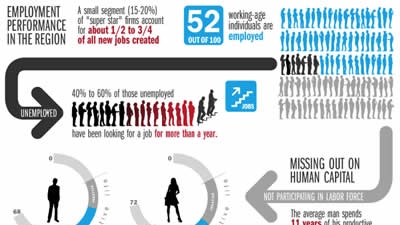7 November, 2013 - Only 52 out of every 100 working-age people in Europe and Central Asia (ECA) are employed currently. And what’s more, up to 60 percent of the unemployed have been searching for jobs for more than a year.
These figures, among others, underscore the need for countries in the region to implement policy changes that span several sectors, going beyond traditional labor market measures and reforms of regulations, in order to grow the economy while creating more and better jobs, according to a new World Bank report, Getting Back to Work: Growing with Jobs in Europe and Central Asia.
Jobs play a central role in people’s lives and are important for the region to achieve shared prosperity, a key goal for the World Bank Group. ECA, much like other regions around the world, suffered after the 2008 economic crisis. Employment and wages fell significantly in most countries, and have not recovered fast enough.
So what can be done to create more and better jobs in the region? The report suggests the following:
- Enable private-sector led job creation: Only about 10 to 15 percent of all companies accounted for over two-thirds of net jobs created in the region before the 2008 crisis, highlighting the need for policy changes that support employment growth among existing firms and encourage new firms to emerge and succeed or fail fast and at low cost. Some ways of doing this include continued reforms to improve competition, property registration, taxation, and infrastructure.
- Helping workers acquire the right skills: Companies now place more emphasis on cognitive and “soft” skills, over routine, manual skills. But according to international standardized tests one in five 15-year-olds is functionally illiterate in the region – i.e. their education failed to deliver the basic cognitive skills that companies demand. Steps such as improving early childhood development policies, expanding quality preschool and basic education, assuring quality of the expanding tertiary education, addressing market failures and providing incentives for more on-the-job training can help.
- Addressing work disincentives in taxes and social protection systems: On average, income taxes and social security contributions amount to 37 percent of labor costs in the region. Also, existing pension systems often encourage early retirement, adding to the number of inactive working-age population in the region. Reducing labor taxation, especially for low-income workers, developing smart safety net and carrying fundamental pension reforms are critical to get more people to work and longer working lives, according to the report.
- Eliminating employment hurdles for women, minorities, youth and older workers: Other barriers exist outside the labor market, such as lack of child or senior care options, limited flexible work arrangements and other social norms, that restrict access to economic opportunities among women, and young and older workers. Removing or minimizing the impact of these barriers by providing good child and senior care options and flexibility in work schedules will help bring more people into the workforce.
- Removing obstacles to internal migration: While people do move internationally, mobility within countries, especially for older workers, is low. Supporting the development of housing and credit markets, eliminating administrative residential requirements from the socialist legacy, making social benefits portable and making basic services accessible easily everywhere are some of the measures that countries can take to spur domestic migration that brings workers to places with more job creation potential are.
These measures, along with improving the business climate, making labor markets more competitive, modernizing the public sector, overhauling financial development and integrating better with global markets are necessary for economic growth along with positive and sustained job creation across the region.
-----------------------------------
Infographics
Chapter 1: The Role of Legacy and Demographics (PDF)
Chapter 2: Fostering Private Sector Job Creation: Entrepreneurship and Gazelles (PDF)
Chapter 3: Skills Wanted: Building Skills for the Modern Workplace (PDF)
Chapter 4: Disincentives & Barriers to Employment in Europe and Central Asia (PDF)
Chapter 5: Labor Mobility: Leading Workers to Jobs (PDF)


